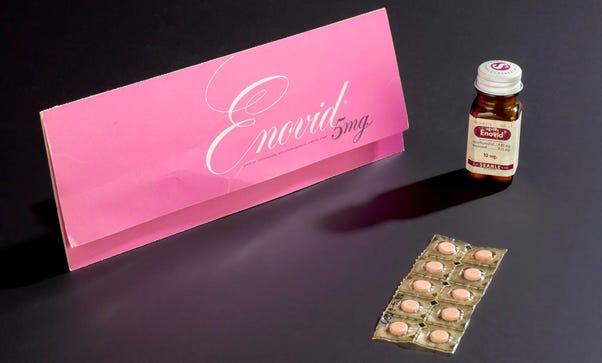Sexual Anarchy: the Pill at 60
The oral contraceptive is celebrating its 60th anniversary this year. Join us as we wish a happy birthday to the world’s most famous pill – and unearth some surprising facts about its development.
By Marie Fury

In the first year it became available, 400,000 US women saw their doctors about getting a prescription for Enovid-10, the original birth control pill. And no wonder, given that options pre-Pill were often inconvenient, ineffective, and/or reliant on male cooperation. The Pill revolutionised contraception. But how much do you know about the early life of this “magic pill”? Pop on Loretta Lynn’s classic ode to birth control, The Pill, and read on...
Ins and outs
The invention of the Pill wasn’t solely driven by science – demand for more effective contraception had been building for years as women campaigned for the right to control their fertility, in particular, Planned Parenthood founder (and eugenics advocate 😱) Margaret Sanger.
The scientists behind the Pill were men (chemists Carl Djerassi and Frank Colton, and biologists John Rock and Gregory Pincus – cheers dudes!) but the money needed to bring the drug to market came from wealthy women’s right activist and MIT graduate Katharine Dexter McCormick (brilliantly, she is also famous for smuggling thousands of then-illegal diaphragms into the USA during the 1920s, sewn into the linings of her coats!).
Originally the Pill was only going to contain progesterone, but oestrogen was accidentally produced during synthesis of the drug for the initial clinical trials. When the scientists removed the oestrogen, women experienced breakthrough bleeding (bleeding outside the pill-free week) so they decided to leave it in.
The Pill has done a lot of good for women around the world but its development was not always ethical. The drug was tested on women who had not given informed consent, including inmates of a psychiatric hospital and hundreds of poor women in Puerto Rico.
In early trials, the combined Pill was given every day. The 1-week gap was introduced because it was thought that women would prefer to still bleed monthly (er, would we?) and because the developers hoped mimicking the natural cycle would avoid opposition from the Catholic Church (LOL, no). It’s totally fine to take the Pill continuously if you prefer.
The Pill was actually approved for sale in 1957 – but only for treating “menstrual disorders”. When it was finally given the green light for birth control, it was initially available to married women only. A pearl-clutching 1966 article in U.S. News & World Report suggested that the Pill would lead to “sexual anarchy”. 😂 In the UK, the Pill was finally made available to unmarried women in 1967. In the US, it took a Supreme Court ruling in 1972. If there’s one thing that terrifies the patriarchy, its women having control of their own bodies and sexuality!
Ups and downs
While the Pill offered freedom to many women, it was designed, marketed, and prescribed by male-dominated and paternalistic pharmaceutical and medical systems – so it’s no surprise there were some issues...
Early versions of the Pill contained several times the level of hormones found in today’s combined oral contraceptives, causing a variety of side effects from nausea to increased risk of blood clots. But reports of serious side effects in clinical trial subjects were ignored and women were typically given no information on risks. Doctors policed women’s access to the Pill and presumably expected those graced with a prescription to be grateful and not ask questions.
In the 1970s, campaigning from feminist groups led to further research and hormone levels were gradually dropped to safer levels. Warnings about side effects were added to packaging so that patients could make up their own minds about the risks – an innovation that was later adopted for all drugs.
Today’s oral contraceptives are generally very safe (in many countries they are available over the counter). There is a small increased risk of some conditions, like breast and cervical cancers and blood clots. But the Pill also has a protective effect against ovarian and endometrial cancer and can help with menstrual problems like endometriosis, polycystic ovaries, and heavy periods. Recently, it’s even been found to reduce the severity of asthma in women. Most importantly, the Pill protects against the potentially huge physical and mental damage of (unwanted) pregnancy.
The Pill may not be not perfect but the availability of easy-to-use, discreet contraception has been revolutionary – for women as individuals, and for society as a whole.
Coming soon - what’s next for contraception? From the male pill to fertility apps, we explore the next generation of birth control.
Read more…
60 Years of the Combined Oral Contraceptive Pill – nice infographic
Repackaging the Pill – how the Pill changed the pharmaceutical industry
60 Years Ago, We Got the Pill. Today, We're Fighting to Keep It. – why access to birth control in the US is under threat (😡)
How The Approval Of The Birth Control Pill 60 Years Ago Helped Change Lives – hear from women who lived through the advent of the Pill





